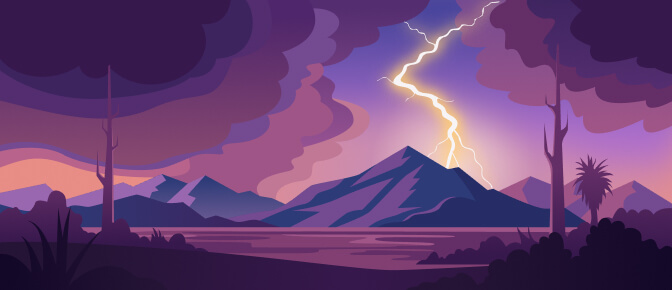In the early days of August 2023, a series of destructive wildfires ignited in Hawaii, primarily on Maui Island. The Maui wildfires forced many residents to evacuate and destroyed many homes and businesses. Sadly, the fire led to more than 100 deaths. The Hawaii forest fires have also left 338 people missing.
A powerful high-pressure system north of Hawaii and Hurricane Dora to the south created dry weather. These drought conditions contributed to the quick spreading of the fires, making them one of the worst wildfires Hawaii ever saw. The Maui fires were hard to control and caused a lot of damage, having joined the list of the deadliest wildfires in U.S. history.
| Wildfire | Deaths |
|---|---|
| Peshtigo (1871) | 1,152 |
| Cloquet (1918) | 453 |
| Great Hinckley (1894) | 418 |
| Thumb (1881) | 282 |
| Maui (2023) | 115 |
Now let’s explore the chronology of fires in Maui and find out what caused Hawaii fires.
Hawaii Maui Fires: Timeline
According to the authorities, September and October typically have the highest wildfire risk in Hawaii, but now the Hawaii fire season is no longer predictable. On Aug.7, the National Weather Service warned that some parts of Maui County would have strong winds.
Meteorologists said that the Hawaiian wildfire got worse because of the high winds from Hurricane Dora. The wind gusts reached 67 mph (107 km/h) in some places during the week. Besides, the Hawaii fire spread rapidly because of the dry weather and a plant that creates lots of dry vegetation: guinea grass. Another reason that might have caused the wild fire in Hawaii was a tree hitting a powerline.
 Source: University of Hawaii
Source: University of Hawaii
The wildfire in Hawaii consisted of three main parts:
- Upcountry
- Lahaina
- Pulehu (South)
For better understanding, here is the Maui wildfires map:
 Source: NASA, The Independent
Source: NASA, The Independent
On 08/08, the first brush fire occurred in the middle of the island - Kula, and it was called the Upcountry fire. A few hours later, another Hawaii forest fire started near the historic town of Lahaina. The Lahaina fire got much worse by the night. It was spreading so fast that people could not escape by car. They had to leave their houses and rush into pools or the ocean for safety. The fire burned the entire town. Another fire, the Pulehu fire, started in the south of the island on the same day. The first six deaths were reported on August 9. On the next day, the death toll rose to 55. The firefighters contained (surrounded by perimeter) 70% of the Pulehu fire and 80% of the Lahaina fires. On August 11, 50% of the Upcountry Maui fire, 80% of the Pulehu fire, and 85% of the Lahaina fire were contained. Meanwhile, the number of deaths went up to 80. A day later, the Pulehu fire was completely surrounded. On 08/14, 99 people were confirmed dead.
The wildfire outbreak left behind more than 2,000 acres of burned land in Lahaina. The Upcountry fire burned 678 acres and was mostly surrounded. The number of deaths grew to 101 by Aug.15. The next day, a total of 106 people were found dead. Hawaii Governor Josh Green said that many of the victims were found on the road near the water. The hurricane made the fire very hot - 1,000 °F (538 °C) - and very fast. The fire melted metal and granite and car engines, releasing bad chemicals.
 Source: Ku‘u Kauanoe, Civil Beat
Source: Ku‘u Kauanoe, Civil Beat
How did Hawaii fires start? On 08/16, Bob Marshall, CEO of the power monitoring company Whisker Labs, reported that the power grid was overloaded because of high winds. This caused over 100 power line faults, one of which could have started the fire.
On August 17, the death toll reached 111. As of Aug.18, approximately 58% of the destroyed area had been searched. 114 deaths were confirmed on the next day, and 78% of the area had been searched. The Lahaina Hawaii fires were reported 90% contained while the Kula fires were surrounded by 85%. On 08/21, 115 deadly victims were confirmed.
On Aug.24, Maui County sued Hawaiian Electric Company. They said that the utility company failed to cut off power during the forest fires. As a response, Hawaiian Electric Company admitted that its power lines were one of the reasons Hawaii fires started. However, they blamed the county firefighters for leaving the scene after saying that the fire was under control, only to have another fire start nearby.
On 08/26, the authorities lifted the evacuation order for Lahaina, meaning that it was safe for people to return to the town.
Fires on Hawaii: Consequences
The Lahaina fire killed 115 people for sure, and 338 more are missing (as of Aug.26). By August 24, only 21 of the dead people had been identified. As of Aug.18, the fires had injured at least 67 people.
Lahaina suffered greatly from the Maui wildfires. The fires destroyed more than 2,200 buildings, as reported by the Pacific Disaster Center (PDC) and the Federal Emergency Management Agency (FEMA). Most of the buildings were homes, and many historic landmarks in Lahaina were also burned down. According to the wildfire damage assessment by FEMA, the fires caused a huge economic loss of almost $6 billion.
 Source: Rick Bowmer/AP, NBC News
Source: Rick Bowmer/AP, NBC News
However, on August 16, Karen Clark & Co., a catastrophe modeling firm, said that the insurance companies would pay only $3.2 billion for the property damage. Real estate experts worried that many Lahaina houses did not have enough insurance or no insurance at all. As a result, the owners who survived might not have enough money to build new houses that follow the state’s building rules. Some people who escaped the disaster are also worried that land developers and buyers might take over their island and force the native Hawaiians to leave.
The wildfire impact on Hawaii ecosystems was also catastrophic. On August 11, people in Lahaina and Upper Kula were told not to use or drink the water from the tap because it was not safe. Trucks with clean water were sent to different places on the island. Some scientists also said that the burned soil, the top soil with bad chemicals, and other debris could go into the water near the shore. This could hurt sea life and people living nearby.

Source: Google Earth Pro / Getty Images
Conclusion
The wildfire Hawaii event of 2023 was a tragedy that claimed the lives of over 100 people and left hundreds missing. The fires, fueled by strong wind and dry conditions, ravaged the island of Maui, especially the historic town of Lahaina. This was one of the most tragic wildfires Maui ever experienced.
The flames also destroyed thousands of buildings, causing billions of dollars in damage and leaving many residents homeless. Besides, the blazes posed a threat to the water quality and the marine ecosystem. The 2023 fires in Hawaii, Maui became one of the deadliest and most destructive wildfire complexes in the recorded history of the United States.






